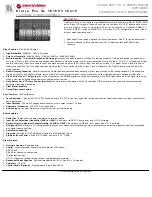
xStack® DGS-3620 Series Managed Switch Web UI Reference Guide
203
•
In IGMP v2, Membership reports could contain only one multicast group whereas in v3, these reports can
contain multiple multicast groups and multiple sources within the multicast group.
•
Leaving a multicast group could only be accomplished using a specific leave message in v2. In v3, leaving
a multicast group is done through a Membership report, which includes a block message in the group
report packet.
•
For version 2, the host could respond to a group query but in version 3, the host is now capable to answer
queries specific to the group and the source.
IGMP v3 is backwards compatible with other versions of IGMP.
The IGMPv3 Type supported codes are shown below:
Type
Meaning
0x11
Membership Query
0x12
Version 1 Membership Report
0x16
Version 2 Membership Report
0x17
Version 2 Leave Group
0x22
IGMPv3 Membership Report
As previously mentioned, IGMPv3 incorporates filters to include or exclude sources. These filters are kept updated
using timers. IGMPv3 utilizes two types of timers, one for the group and one for the source. The purpose of the
filter mode is to reduce the reception state of a multicast group so that all members of the multicast group are
satisfied. This filter mode is dependant on membership reports and timers of the multicast group. These filters are
used to maintain a list of multicast sources and groups of multicast receivers that more accurately reflect the actual
sources and receiving groups at any one time on the network.
Timers
Source timers are used to keep sources present and active within a multicast group on the Switch. These source
timers are refreshed if a group report packet is received by the Switch, which holds information pertaining to the
active source group record part of a report packet. If the filter mode is exclude, traffic is being denied from at least
one specific source, yet other hosts may be accepting traffic from the multicast group. If the group timer expires for
the multicast group, the filter mode is changed to include and other hosts can receive traffic from the source. If no
group report packet is received and the filter mode is include, the Switch presumes that traffic from the source is no
longer wanted on the attached network and the source record list is then deleted after all source timers expire. If
there is no source list record in the multicast group, the multicast group will be deleted from the Switch.
Timers are also used for IGMP version 1 and 2 members, which are a part of a multicast group when the Switch is
running IGMPv3. This timer is based on a host within the multicast group that is running IGMPv1 or v2. Receiving a
group report from an IGMPv1 or v2 host within the multicast group will refresh the timer and keep the v1 and/or v2
membership alive in v3.
NOTE:
The length of time for all timers utilized in IGMPv3 can be determined using
IGMP configurations to perform the following calculation:
(Query Interval x Robustness Variable) + One Query Response Interval
IGMP Interface Settings
The Internet Group Management Protocol (IGMP) can be configured on the Switch on a per-IP interface basis.
Each IP interface configured on the Switch is displayed in the below IGMP Interface Settings window.
To view the following window, click
L3 Features > IP Multicast Routing Protocol > IGMP > IGMP Interface
Settings
, as shown below:
Figure 5-67 IGMP Interface Settings window
Содержание DGS-3620-28PC-SI
Страница 1: ......
















































